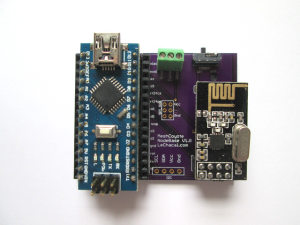MeshCoyote: Difference between revisions
No edit summary |
|||
| (8 intermediate revisions by the same user not shown) | |||
| Line 1: | Line 1: | ||
=Overview= | =Overview= | ||
| Line 18: | Line 16: | ||
MeshCoyote uses radio transmitters nrf24l01. RF24 for a short name. | MeshCoyote uses radio transmitters nrf24l01. RF24 for a short name. | ||
All communications are self organised. The network builds itself using every reachable neighbours. If a node is moved the network is able to re-organise itself around the new topology. | |||
=Hardware= | =Hardware= | ||
We propose two types of hardware. Sensor nodes and recording node. | |||
[[File:IMG_1247_small.png | right | 300px]] | |||
==Sensor Nodes== | |||
The [[NanoRF24]] is a hosting board for Arduino Nano and RF24. This is the base communication unit with Arduino programmable microcontroller. | |||
The NanoRF24 has a temperature sensor port to host a DS18B20 sensor. | |||
Other sensors can be added with the i2c port. | |||
==Recording Node== | |||
[[File:IMG_1232_small.png | right | 300px]] | |||
The RPIRF24 has been designed to adapt a RF24 module onto a Raspberrypi. The Raspberrypi is an ideal solution as a recording or forwarding module. | |||
[[rf24_on_rpi | RF24 on Raspberrypi]] | |||
Latest revision as of 14:57, 9 July 2017
Overview
MeshCoyote is a multipoint measurement system. It uses mesh network topology to carry all node measurements to a single recorder or data forwarder.
For now the project only measure temperature but this will soon be extended to Power usage, Voltage, Current, Anemometer etc.
A "node" is a single device where a measurement is made. All nodes are able to communicate with each other to carry al messages to the master node. This master node (or recorder node) is able to save the data locally or forward them to any other database such as Emoncms, Influxdb or else.

Mesh Network
Mesh technology offer the possibility to greatly extend communication range. Every node is a repeater to allow communication between the recorder and a node spatially located out of the direct path range of the recorder.
MeshCoyote uses radio transmitters nrf24l01. RF24 for a short name.
All communications are self organised. The network builds itself using every reachable neighbours. If a node is moved the network is able to re-organise itself around the new topology.
Hardware
We propose two types of hardware. Sensor nodes and recording node.

Sensor Nodes
The NanoRF24 is a hosting board for Arduino Nano and RF24. This is the base communication unit with Arduino programmable microcontroller. The NanoRF24 has a temperature sensor port to host a DS18B20 sensor. Other sensors can be added with the i2c port.
Recording Node

The RPIRF24 has been designed to adapt a RF24 module onto a Raspberrypi. The Raspberrypi is an ideal solution as a recording or forwarding module. RF24 on Raspberrypi